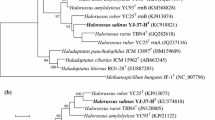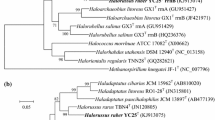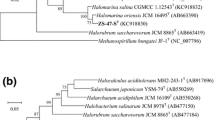Abstract
Two halophilic archaeal strains TBN4T and TBN5 were isolated from Taibei marine solar saltern in Jiangsu, China. Both strains showed light red-pigmented colonies and their cells were rod, motile and Gram-stain-negative. They were able to grow at 25–50°C (optimum 37°C), at 1.4–4.3 M NaCl (optimum 2.1 M NaCl), at 0–1.0 M MgCl2 (optimum 0.005 M MgCl2) and at pH 6.0–9.0 (optimum pH 7.0). Their cells lyse in distilled water and minimal NaCl concentration to prevent cell lysis is 8% (w/v). The major polar lipids of the two strains were PG (phosphatidylglycerol), PGP-Me (phosphatidylglycerol phosphate methyl ester), PGS (phosphatidylglycerol sulfate) and five glycolipids chromatographically identical to S-TGD-1 (sulfated galactosyl mannosyl glucosyl diether), S-DGD-1 (sulfated mannosyl glucosyl diether), TGD-1 (galactosyl mannosyl glucosyl diether), DGD-1 (mannosyl glucosyl diether) and DGD-2 (an unknown diglycosyl diether). Phylogenetic analysis revealed that TBN4T and strain TBN5 formed a distinct clade with genus Haladaptatus (showing 90.0–90.9% 16S rRNA gene similarities). The DNA G + C content of strain TBN4T and strain TBN5 are 66.1 and 65.4 mol%, respectively. The DNA–DNA hybridization value between strain TBN4T and strain TBN5 was 94.3%. The phenotypic, chemotaxonomic and phylogenetic properties suggest that strain TBN4T and strain TBN5 represent a novel species in a new genus within the family Halobacteriaceae, for which the name Halorussus rarus gen. nov., sp. nov. is proposed. The type strain is TBN4T (=CGMCC 1.10122T = JCM 16429T).



Similar content being viewed by others
References
Antón J, Oren A, Benlloch S, Rodríguez-Valera F, Amann R, Rosselló-Mora R (2002) Salinibacter ruber gen. nov., sp. nov., a novel, extremely halophilic member of the Bacteria from saltern crystallizer ponds. Int J Syst Evol Microbiol 52:485–491
Antunes A, Taborda M, Huber R, Moissl C, Nobre MF, da Costa MS (2008) Halorhabdus tiamatea sp. nov., a non-pigmented, extremely halophilic archaeon from a deep-sea, hypersaline anoxic basin of the Red Sea, and emended description of the genus Halorhabdus. Int J Syst Evol Microbiol 58:215–220
Castillo AM, Gutiérrez MC, Kamekura M, Ma YH, Cowan DA, Jones BE, Grant WD, Ventosa A (2006) Halovivax asiaticus gen. nov., sp. nov., a novel extremely halophilic archaeon isolated from Inner Mongolia, China. Int J Syst Evol Microbiol 56:765–770
Chun J, Lee JH, Jung Y, Kim M, Kim S, Kim BK, Lim YW (2007) EzTaxon: a web-based tool for the identification of prokaryotes based on 16S ribosomal RNA gene sequences. Int J Syst Evol Microbiol 57:2259–2261
Cui HL, Lin ZY, Dong Y, Zhou PJ, Liu SJ (2007) Halorubrum litoreum sp. nov., an extremely halophilic archaeon from a solar saltern. Int J Syst Evol Microbiol 57:2204–2206
Cui HL, Zhou PJ, Oren A, Liu SJ (2009) Intraspecific polymorphism of 16S rRNA genes in two halophilic archaeal genera, Haloarcula and Halomicrobium. Extremophiles 13:31–37
Cui HL, Sun FF, Gao X, Dong Y, Xu XW, Zhou YG, Liu HC, Oren A, Zhou PJ (2010) Haladaptatus litoreus sp. nov., an extremely halophilic archaeon from a marine solar saltern, and emended description of the genus Haladaptatus. Int J Syst Evol Microbiol 60:1085–1089
De Ley J, Cattoir H, Reynaerts A (1970) The quantitative measurement of DNA hybridization from renaturation rates. Eur J Biochem 12:133–142
Dussault HP (1955) An improved technique for staining red halophilic bacteria. J Bacteriol 70:484–485
Euzéby J (2010) Notification that new names and new combinations have appeared in volume 60, part 5, of the IJSEM. Int J Syst Evol Microbiol 60:1715–1716
Felsenstein J (1981) Evolutionary trees from DNA sequences: a maximum likelihood approach. J Mol Evol 17:368–376
Fitch WM (1971) Toward defining the course of evolution: minimum change for a specific tree topology. Syst Zool 20:406–416
Gonzalez C, Gutierrez C, Ramirez C (1978) Halobacterium vallismortis sp. nov. an amylolytic and carbohydrate-metabolizing, extremely halophilic bacterium. Can J Microbiol 24:710–715
Gutiérrez C, González C (1972) Method for simultaneous detection of proteinase and esterase activities in extremely halophilic bacteria. Appl Microbiol 24:516–517
Gutiérrez MC, Castillo AM, Kamekura M, Ventosa A (2008) Haloterrigena salina sp. nov., an extremely halophilic archaeon isolated from a salt lake. Int J Syst Evol Microbiol 58:2880–2884
Huß VAR, Festl H, Schleifer KH (1983) Studies on the spectrophotometric determination of DNA hybridization from renaturation rates. Syst Appl Microbiol 4:184–192
Kates M (1986) Techniques of lipidology, 2nd edn. Elsevier, Amsterdam, pp 106–107, 241–246
Kumar S, Dudley J, Nei M, Tamura K (2008) MEGA: a biologist-centric software for evolutionary analysis of DNA and protein sequences. Briefings Bioinf 9:299–306
McDade JJ, Weaver RH (1959) Rapid methods for the detection of gelatin hydrolysis. J Bacteriol 77:60–64
Mesbah M, Premachandran U, Whitman WB (1989) Precise measurement of the G + C content of deoxyribonucleic acid by high-performance liquid chromatography. Int J Syst Evol Bacteriol 39:159–167
Namwong S, Tanasupawat S, Visessanguan W, Kudo T, Itoh T (2007) Halococcus thailandensis sp. nov., from fish sauce in Thailand. Int J Syst Evol Microbiol 57:2199–2203
Ng WL, Yang CF, Halladay JT, Arora P, DasSarma S (1995) Protocol 25: isolation of genomic and plasmid DNAs from Halobacterium halobium. In: DasSarma S, Fleischmann EM (eds) Archaea: a laboratory manual: halophiles. Cold Spring Harbor Laboratory Press, Cold Spring Harbor, pp 179–180
Oren A (2006) The order Halobacteriales. In: Dworkin M, Falkow S, Rosenberg E, Schleifer KH, Stackebrandt E (eds) The prokaryotes, vol 3, 3rd edn. Springer, New York, pp 113–164
Oren A, Ventosa A, Grant WD (1997) Proposed minimal standards for description of new taxa in the order Halobacteriales. Int J Syst Bacteriol 47:233–238
Oren A, Arahal DR, Ventosa A (2009) Emended descriptions of genera of the family Halobacteriaceae. Int J Syst Evol Microbiol 59:637–642
Purdy KJ, Cresswell-Maynard TD, Nedwell DB, McGenity TJ, Grant WD, Timmis KN, Embley TM (2004) Isolation of haloarchaea that grow at low salinities. Environ Microbiol 6:591–595
Roh SW, Nam YD, Chang HW, Sung Y, Kim KH, Lee HJ, Oh HM, Bae JW (2007) Halalkalicoccus jeotgali sp. nov., a halophilic archaeon from shrimp jeotgal, a traditional Korean fermented seafood. Int J Syst Evol Microbiol 57:2296–2298
Saitou N, Nei M (1987) The neighbor-joining method: a new method for reconstructing phylogenetic trees. Mol Biol Evol 4:406–425
Savage KN, Krumholz LR, Oren A, Elshahed MS (2007) Haladaptatus paucihalophilus gen. nov., sp. nov., a halophilic archaeon isolated from a low-salt, sulfide-rich spring. Int J Syst Evol Microbiol 57:19–24
Savage KN, Krumholz LR, Oren A, Elshahed MS (2008) Halosarcina pallida gen. nov., sp. nov., a halophilic archaeon from a low-salt, sulfide-rich spring. Int J Syst Evol Microbiol 58:856–860
Stackebrandt E, Goebel BM (1994) Taxonomic note: a place for DNA–DNA reassociation and 16S rRNA sequence analysis in the present species definition in bacteriology. Int J Syst Bacteriol 44:846–849
Wang QF, Li W, Yang H, Liu YL, Cao HH, Dornmayr-Phaffenhuemer M, Stan-Lotter H, Guo GQ (2007) Halococcus qingdaonensis sp. nov., a halophilic archaeon isolated from a crude sea-salt sample. Int J Syst Evol Microbiol 57:600–604
Xin H, Itoh T, Zhou P, Suzuki K, Kamekura M, Nakase T (2000) Natrinema versiforme sp. nov., an extremely halophilic archaeon from Aibi salt lake, Xinjiang, China. Int J Syst Evol Microbiol 50:1297–1303
Xu Y, Zhou P, Tian X (1999) Characterization of two novel haloalkaliphilic archaea Natronorubrum bangense gen. nov., sp. nov. and Natronorubrum tibetense gen. nov., sp. nov. Int J Syst Bacteriol 49:261–266
Xu XW, Wu YH, Wang CS, Oren A, Zhou PJ, Wu M (2007) Haloferax larsenii sp. nov., an extremely halophilic archaeon from a solar saltern. Int J Syst Evol Microbiol 57:717–720
Xue YF, Fan HP, Ventosa A, Grant WD, Jones BE, Cowan DA, Ma YH (2005) Halalkalicoccus tibetensis gen. nov., sp. nov., representing a novel genus of haloalkaliphilic archaea. Int J Syst Evol Microbiol 55:2501–2505
Acknowledgments
This work was supported by the National Natural Science Foundation of China (No. 30970006) and the opening project of State key Laboratory of Microbial Resources, Institute of Microbiology, Chinese Academy of Sciences (No. SKLMR-20100604).
Author information
Authors and Affiliations
Corresponding author
Additional information
Communicated by A. Oren.
Electronic supplementary material
Below is the link to the electronic supplementary material.
Rights and permissions
About this article
Cite this article
Cui, HL., Gao, X., Yang, X. et al. Halorussus rarus gen. nov., sp. nov., a new member of the family Halobacteriaceae isolated from a marine solar saltern. Extremophiles 14, 493–499 (2010). https://doi.org/10.1007/s00792-010-0329-0
Received:
Accepted:
Published:
Issue Date:
DOI: https://doi.org/10.1007/s00792-010-0329-0




